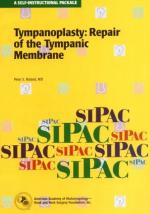|
This section contains 315 words (approx. 2 pages at 300 words per page) |
Most commonly called the eardrum, the tympanic membrane is an oval-shaped, thin, fibrous membrane that covers the ear canal separating the outer ear (external acoustic meatus) from the middle ear (tympanum).
The tympanic membrane is bilaminar with the mucous membrane inner portion covered by epithelial skin.
In response to sound waves funneled into the ear canal, the tympanic membrane vibrates. The degree of vibration depends upon the frequency and amplitude (energy) or the sound wave. The vibrations of the tympanic membrane are then transmitted via the malleus of the middle ear (the hammer) to the incus and stapes bones of the middle ear. The energy transmitted via the sound waves in the external ear canal is converted via the tympanic membrane and middle ear structures into wave-like fluid disturbances in the inner ear.
Excessive vibration of the tympanic membrane caused by chronic exposure to loud music, jet noise, etc., usually leads to a diminished vibratory response in the tympanic membrane and a loss or lessening of the ability to hear at certain frequencies. Although there are other causes, there is often an in ability to hear softer sounds across a range of frequencies. There is also a broader loss of hearing associated with a rupture of the tympanic membrane. In addition to a loss of hearing due directly to the rupture, there is often a persistent loss of hearing ability as a result of scar tissue formation on the healed or repaired tympanic membrane.
The amount of hearing loss associated with membrane perforation depends upon the exact location and size of the perforation. In most cases, bony conduction of sound wave induced vibrations in the skull prevents, and offers a limited compensatory mechanism, to total hearing loss. In some cases the tympanic membrane is deliberately ruptured during a surgical procedure (myringotomy) to relieve pressure on the middle ear resulting from infection.
|
This section contains 315 words (approx. 2 pages at 300 words per page) |


